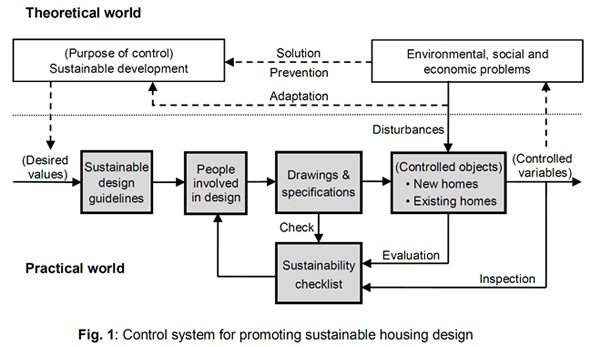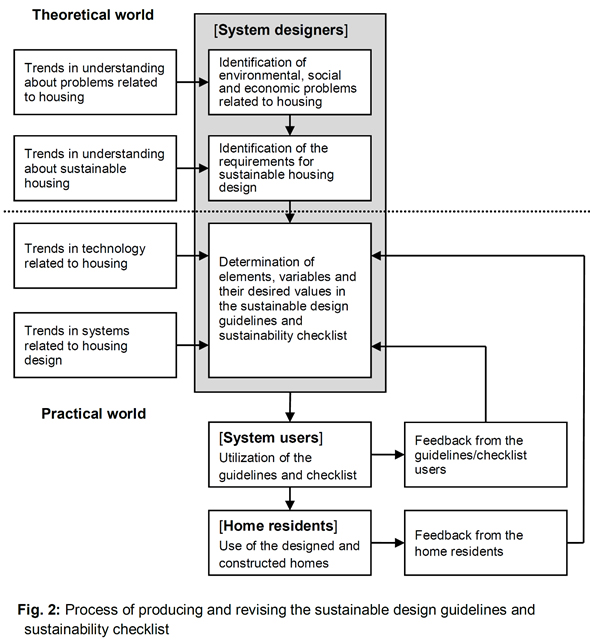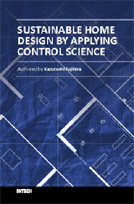Institute of Environmentology, Research and Education for Sustainability or Sustainable Development, Kazutoshi Fujihira
Sustainable Housing Research
Institute of Environmentology >> Sustainable Housing Research
Control system for promoting sustainable housing design
Utilizing the “basic control system for sustainable development,” we have formed the “control system for promoting sustainable housing design” (Fig. 1). The upper area of the figure is the theoretical world; the lower area is the practical world.
“Disturbances” are harmful influences on controlled objects which are caused by environmental, social, or economic problems, such as various impacts resulting from climate change. The route from “disturbances” to “sustainable development” is “adaptation.” The purpose of control is the achievement of “sustainable development.”
“Desired values” are derived from “sustainable development.” Meanwhile, “controlled variables” are the variables that relate to controlled objects and need to be controlled for primarily solving or preventing the problems or adapting to disturbances. The control objective of this control system is to adjust the controlled variables to their desired values.

In the practical world, controlled objects are both “new homes” and “existing homes.” “People involved in design,” such as homeowners, designers, architects and homebuilders, adjust the controlled variables to their desired values, by utilizing the “sustainable design guidelines” and “sustainability checklist.” Both the design guidelines and checklist have almost the same structure, namely elements, variables and their desired values. However, the checklist is created to easily compare measured or estimated variables with the desired values and search for controlled variables.
(1) New homes
When objects are new homes, first, information on the desired values reaches “people involved in design” through the “sustainable design guidelines.” People involved make “drawings and specifications,” so that the variables of home’s elements can attain their desired values as much as possible. At important steps in the design process, people involved check the drawings and specifications, by referring to the “sustainability checklist.”
(2) Existing homes
When existing homes are objects, the design process begins with “inspection” on the home as an object. The “people involved in design” measure or estimate each element’s variables of that home by referring to the “sustainability checklist.” After the inspection, the people involved usually make “drawings and specifications” for improvement, so that controlled variables satisfy their desired values as much as possible.
Process of producing and revising the design guidelines and checklist
The process of producing and revising the sustainable design guidelines and sustainability checklist is shown in Fig 2. The upper and lower area divided by the dotted line represent the “theoretical world” and the “practical world,” respectively.
The central part demonstrates the course of preparing and using the “sustainable design guidelines” and “sustainability checklist.” First, system designers produce or revise the guidelines and checklist through the three-stage process. Next, system users utilize the guidelines and checklist. After that, the residents use the actual homes that have been designed with the guidelines and checklist.
The four blocks on the left show the items to check when producing or revising the guidelines and checklist. The contents in these four items can change over time. Meanwhile, the two blocks on the lower right show the items to check when revising the guidelines and checklist, based on the feedback from the system users and home residents.

1. Process of producing the design guidelines and checklist
The process of producing the design guidelines and checklist consists of three stages: (1) identification of environmental, social and economic problems related to housing, (2) identification of the requirements for sustainable housing design, and (3) determination of elements, variables and their desired values in the design guidelines and checklist.
(1) Identification of problems related to housing
Observing trends in understanding about environmental, social and economic problems related to housing, system designers identify problems and make a list of housing-related problems. The basis for the identification is that the problems affect the six stability conditions that have been shown in the model of sustainable development, namely health, safety, mutual help, self-realization, environmental preservation, and sustainable use of natural resources. When identifying problems, system designers take up both global/general problems and local/particular problems in their region or country.
(2) Identification of the requirements for sustainable housing design
In the second stage, based on the identified problems related to housing, system designers identify the requirements for sustainable housing design. For example, if “climate change” is identified as a problem in the first stage, “energy saving,” “use of renewable energy,” and “conservation of green space” are usually identified as the requirements.
(3) Determination of elements, variables and their desired values
In the third stage, the requirements for sustainable housing design are converted into the “element-variable-desired value” structure of the guidelines and checklist. The purpose of this conversion is the convenience of users in the practical world. The structure of “element-variable-desired value” shows design targets of each part of homes; therefore, it enables users to easily understand what should be designed and the courses of design.
When selecting “elements,” it is helpful for system designers to base the selection on two factors: “material” and “space.” “Material” regards housing as the aggregate of material elements, such as framework, exterior, thermal insulation, windows and doors, interior, and piping. “Space” considers housing as the aggregate of spatial elements, such as rooms and areas. When determining “elements,” system designers also consider the requirements for sustainable housing design. For example, when “use of renewable energy” is identified as a requirement for sustainable housing design, “equipment for harnessing renewable energy” should be selected as one of material elements.
When determining “variables,” system designers examine the relationships between each element and the relevant stability condition(s), as well as the related requirement(s) for sustainable housing design. For instance, when identifying a variable of “equipment for harnessing renewable energy,” it is necessary to examine the relationships between this element and the relevant stability conditions, namely environmental preservation and sustainable use of natural resources, as well as the related requirement, namely use of renewable energy. As a result, “harnessed renewable energy” can be determined as its variable.
After determining variables, system designers set the variables’ “desired values” so that they can meet the relevant stability conditions. If “harnessed renewable energy” is the variable, its desired value can be set at “100% or more of the total energy usage,” which is considered to satisfy the relevant stability conditions, namely environmental preservation and sustainable use of natural resources. When “desired values” are set, trends in the housing-related technology and systems related to housing design are also considered.
2. Process of revising the design guidelines and checklist
The “sustainable design guidelines” and “sustainability checklist” need to be revised, for adjustment to changing situations as well as for higher accuracy and user-friendliness. The revision process can be divided into three spheres: (1) changes in the theoretical world, (2) changes in the practical world, and (3) feedback from the users. After making preparations from the above three perspectives, system designers modify the tables of the guidelines and checklist.
(1) Changes in the theoretical world
Noticeable changes over time in the theoretical world are necessary to be reflected in the guidelines and checklist. First, after searching for recent changes in environmental, social and economic problems, system designers can amend the list of housing-related problems. Based on the amended list of problems, the system designers can also amend the list of the requirements for sustainable housing design. When amending these two lists, it is also necessary to observe the latest trends in “understanding about problems related to housing” and “understanding about sustainable housing.” After that, system designers consider modifications on the “element-variable-desired value” structure of the guidelines and checklist.
(2) Changes in the practical world
In addition to changes in the theoretical world, changes in the practical world need to be reflected. Changes over time in the practical world include “changes in technology related to housing” and “changes in systems related to housing design.”
(3) Feedback from the users
As demonstrated in the lower part of Fig 2, “feedback from the guidelines/checklist users” and “feedback from the home residents” are also necessary to be considered. The feedback from the guidelines/checklist users is information about reactions to the guidelines and checklist, including comments on the validity and user-friendliness of these systems. Such information is used as a basis for the improvement of the systems. Meanwhile, the feedback from the home residents is information about reactions to the homes that have been designed with the guidelines and checklist. Such information, including comments on the homes’ amenities and sustainability performance, is also useful for the improvement of the systems.
Characteristics of this methodology
The first characteristic of this methodology is the presentation of a comprehensive strategy for designing and promoting sustainable housing. Fig. 1 concisely shows processes for promoting sustainable design on both new and existing homes with the sustainable design guidelines and sustainability checklist. Fig. 2 demonstrates the process of producing and revising the guidelines and checklist in one diagram. These visualizations are expected to help people to understand the whole picture of designing sustainable homes and promoting them.
The second characteristic is “user-friendliness.” The material and spatial elements shown in “sustainable design guidelines” and “sustainability checklist” are equivalent to real parts of homes. Accordingly, the system users can easily compare the drawings or real home with the guidelines or checklist, when conducting design, check, evaluation, and inspection.
Moreover, the guidelines and checklist have a characteristic of comprehensiveness, owing to the model of sustainability. This model contains a total of six conditions: health, safety, mutual help, self-realization, environmental preservation, and sustainable use of natural resources. Accordingly, the guidelines and checklist can include various considerations, such as measures against climate change, universal design, disaster damage prevention or reduction, communication, working and learning at home.
Related publications
Sustainable Housing Design: System Control Strategy
Fujihira K. IntechOpen; 2021. DOI: 10.5772/intechopen.100126
Different Strategies of Housing Design
Edited by Cakmakli, A., IntechOpen, November 2019
[Chapter 4] Written by Fujihira, K., DOI: 10.5772/intechopen.86278
・Comprehensive Strategy for Sustainable Housing Design
Sustainable Home Design by Applying Control Science

Written by Fujihira, K., InTech, December 2017
Chapter 4
Methodology of Applying Control Science to Sustainable Housing Design
Chapter 6
Discussion and Conclusion: Effectiveness, Characteristics and Future Prospects of the Methodology
Complex Systems, Sustainability and Innovation
Edited by Thomas, C., InTech, December 2016
[Research paper included in this book] Written by Fujihira, K.
・System Control for Sustainability: Application to Building Design
